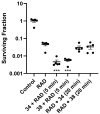Design, Synthesis and Anticancer Evaluation of Nitroimidazole Radiosensitisers
- PMID: 37298933
- PMCID: PMC10254852
- DOI: 10.3390/molecules28114457
Design, Synthesis and Anticancer Evaluation of Nitroimidazole Radiosensitisers
Abstract
The role of hypoxic tumour cells in resistance to radiotherapy, and in suppression of immune response, continues to endorse tumour hypoxia as a bona fide, yet largely untapped, drug target. Radiotherapy innovations such as stereotactic body radiotherapy herald new opportunities for classical oxygen-mimetic radiosensitisers. Only nimorazole is used clinically as a radiosensitiser, and there is a dearth of new radiosensitisers in development. In this report, we augment previous work to present new nitroimidazole alkylsulfonamides and we document their cytotoxicity and ability to radiosensitise anoxic tumour cells in vitro. We compare radiosensitisation with etanidazole and earlier nitroimidazole sulfonamide analogues and we identify 2-nitroimidazole and 5-nitroimidazole analogues with marked tumour radiosensitisation in ex vivo assays of surviving clonogens and with in vivo tumour growth inhibition.
Keywords: DNA damage; chemoradiotherapy; electron affinity; hypoxia; nitroimidazole; prodrugs; radiosensitisers; radiotherapy; sulfonamide; tumour microenvironment.
Conflict of interest statement
The authors declare no conflict of interest.
Figures






Similar articles
-
Next-Generation Hypoxic Cell Radiosensitizers: Nitroimidazole Alkylsulfonamides.J Med Chem. 2018 Feb 8;61(3):1241-1254. doi: 10.1021/acs.jmedchem.7b01678. Epub 2018 Jan 11. J Med Chem. 2018. PMID: 29253343
-
Novel nitroimidazole alkylsulfonamides as hypoxic cell radiosensitisers.Bioorg Med Chem. 2014 Apr 1;22(7):2123-32. doi: 10.1016/j.bmc.2014.02.039. Epub 2014 Mar 3. Bioorg Med Chem. 2014. PMID: 24650701
-
Efficient Protocol for the Identification of Hypoxic Cell Radiosensitisers.Adv Exp Med Biol. 2016;899:269-90. doi: 10.1007/978-3-319-26666-4_16. Adv Exp Med Biol. 2016. PMID: 27325273
-
Radiosensitising agents for the radiotherapy of cancer: advances in traditional and hypoxia targeted radiosensitisers.Expert Opin Ther Pat. 2009 May;19(5):643-62. doi: 10.1517/13543770902824172. Expert Opin Ther Pat. 2009. PMID: 19441939 Review.
-
Overcoming Radioresistance: Small Molecule Radiosensitisers and Hypoxia-activated Prodrugs.Clin Oncol (R Coll Radiol). 2019 May;31(5):290-302. doi: 10.1016/j.clon.2019.02.004. Epub 2019 Mar 8. Clin Oncol (R Coll Radiol). 2019. PMID: 30853148 Review.
Cited by
-
Identification of 6-Anilino Imidazo[4,5-c]pyridin-2-ones as Selective DNA-Dependent Protein Kinase Inhibitors and Their Application as Radiosensitizers.J Med Chem. 2024 Jul 25;67(14):12366-12385. doi: 10.1021/acs.jmedchem.4c01120. Epub 2024 Jul 15. J Med Chem. 2024. PMID: 39007759 Free PMC article.
-
Heterocycles in Medicinal Chemistry II.Molecules. 2024 Oct 11;29(20):4810. doi: 10.3390/molecules29204810. Molecules. 2024. PMID: 39459179 Free PMC article.
References
-
- Pignon J.P., Bourhis J., Domenge C., Designe L. Chemotherapy added to locoregional treatment for head and neck squamous-cell carcinoma: Three meta-analyses of updated individual data. MACH-NC Collaborative Group. Meta-Analysis of Chemotherapy on Head and Neck Cancer. Lancet. 2000;355:949–955. - PubMed
-
- Bentzen S.M., Trotti A. Evaluation of early and late toxicities in chemoradiation trials. J. Clin. Oncol. 2007;25:4096–4103. - PubMed
-
- Harrington K.J., Billingham L.J., Brunner T.B., Chan C.S., Hoskin P., Mackay R.I., Maughan T.S., J Macdougall J., McKenna W.G., Nutting C.M., et al. Guidelines for preclinical and early phase clinical assessment of novel radiosensitisers. Br. J. Cancer. 2011;105:628–639. doi: 10.1038/bjc.2011.240. - DOI - PMC - PubMed
MeSH terms
Substances
Grants and funding
LinkOut - more resources
Full Text Sources
Medical

